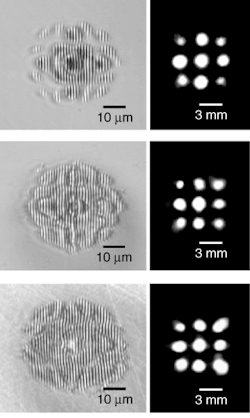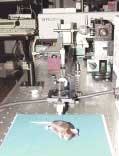Newsbreaks
Experts say no bottlenecks remain to 157-nm lithography
All major obstacles to manufacturing 157-nm optical lithography tools have been overcome, and the industry is planning for insertion of 157-nm lithography at the 65-nm node, said industry experts attending the Third International Symposium on 157-nm Lithography (Antwerp, Belgium). "Although very significant engineering challenges remain, it is believed that the developments are on track targeting insertion in manufacturing," noted Luc Van den Hove, general chair of the symposium and vice president of silicon process and device technology at IMEC (Leuven, Belgium).
"All lens designs for the first-generation 157-nm exposure tools have now been fixed, and suppliers' commitment to deliver the first 157-nm scanners in 2004 is highly encouraging," said Tony Yen, symposium co-chair and a director of lithography at International Sematech. The problem of intrinsic birefringence of calcium fluoride has been solved by using a combination of lens elements made from <111> and <100> crystals, resulting in negligible net birefringence effects. The viability of fused-silica hard pellicles has been demonstrated. Several universities will study the mechanism of photochemical darkening, aiming to develop polymer materials for soft pellicles capable of withstanding 157-nm radiation. Contact Katrien Marent at [email protected].
Illuminated liquid crystal spits out random numbers
One effective approach to generating truly random numbers is based on sensing a particular property of a physical system that is undergoing chaotic fluctuations. James Gleeson, a Kent State University (Kent, OH) associate professor, has developed a technique that follows the fluctuations occurring in a nematic liquid crystal (NLC) as it undergoes electrically induced turbulent convective flow. A laser light source and photodiode sense the turbulence in the material.
A 5 × 5-mm area of NLC is sandwiched between two glass plates 23.5 µm apart. A voltage applied across indium tin oxide transparent electrodes on each plate cause a fully turbulent flow in the NLC. The preamplified signal from the photodetector undergoes a 24-dB/octave low-pass filtering before being digitized by a 12-bit bipolar analog-to-digital converter. To create uniformly distributed random numbers, only some bits in the bit stream are used. A variety of tests for randomness showed that, when the sampling rate was low enough, the output was not distinguishable from that of a true random-number generator. Use of a different NLC material could boost the bit-generation rate. Contact James Gleeson at [email protected].
Femtosecond pulses store data on nonphotosensitive glass
Although holograms are usually written on or in photosensitive materials, they can also be created in ordinary glass, given the proper conditions. A femtosecond laser pulse, for example, provides the combination of high peak power and absence of thermal effects that makes direct writing of gratings in glass possible. Now, researchers at Osaka University (Osaka, Japan) and the Harbin Institute of Technology (Harbin, China) have stored image data in a hologram written onto nonphotosensitive glass.
A regeneratively amplified Ti:sapphire laser provides a 130-fs, 800-nm pulse of a few microjoules at the glass surface. The beam is expanded to provide a uniform intensity at the object mask. Through ablation of the glass caused by the single pulse, a relief microhologram is recorded. The researchers created holograms of a nine-point object in fused silica (top; hologram on left, reconstructed image on right), soda-lime glass (center), and lead glass (bottom). The ablation thresholds of the respective glasses were 18, 13, and 5 J/cm2. Soda-lime glass, the least expensive of the three, is the substrate that would most likely be used if this storage technique became practical. Contact Yan Li at [email protected].
Self-mixing microchip laser measures vibrations
Microchip laser-diode-pumped solid-state lasers are very sensitive to external optical feedback, a characteristic resulting from photon lifetimes that are far shorter than population lifetimes. This quality can be exploited for displacement measurements. Researchers from Tokai University (Kanagawa, Japan) and National Cheng Kung University (Tainan, Taiwan) are using a self-mixing 1320-nm-emitting lithium neodymium tetraphosphate microchip laser to measure nanometer-scale vibrations. Their instrument is based on a simple frequency-demodulation circuit rather than a complicated interferometric setup.
Acousto-optic modulators shift the frequency of the laser beam by an amount on the order of 1 MHz; this light impinges on the target, which in one experiment was a speaker with an aluminum-coated surface vibrating at 8420 Hz at a sound level almost too low to hear. Using amplitude data, the speaker was determined to vibrate at a maximum amplitude of 59 nm for every volt applied to the speaker. The maximum velocity measured reached
10 m/s, implying that measurements can be made on ultrasonic vibrations up to 1 MHz. The speaker was then run at other frequencies; the measured power spectra revealed harmonic vibrations. Contact Kenju Otsuka at [email protected].
Submicron MSM detectors have high ultraviolet response
Metal-semiconductor-metal (MSM) detectors contain two interdigitated Shottky contacts. Researchers at the Ciudad Universitaria (Madrid, Spain), CEA-Grenoble (Grenoble, France), and CNRS (Valbonne, France) have fabricated ultraviolet-sensing gallium nitride-based MSM photodiodes through submicron technology. With the devices' finger-to-finger periodicity reduced in size, their optical responsivity and bandwidth are increased.
Using electron-beam lithography, MSM detectors with fingers ranging from 0.5 to 4 µm in pitch and width were fabricated. The fingers were pure nickel and the devices had areas of 100 × 100 µm. The dark current was less than 50 pA for all versions of the detector. The devices all have a contrast between ultraviolet and visible of greater than 1000. The device with 0.5-µm geometry showed the highest responsivity of 257 mA/W, four times higher than that for the device with 1-µm geometry—a superlinear increase that agrees with predictions. The 0.5-µm devices degraded when operating at a bias voltage greater than 7 V, however. An MSM detector with 0.5-µm features and an active area of 50 × 50 µm should have a time constant of less than 10 ps, according to simulations. Contact Tomas Palacios at [email protected].
Laser-based free-space link has 512 channels
Researchers at McGill University (Montreal, Quebec, Canada) have developed a free-space parallel optical interconnect to connect two printed-circuit boards. The apparatus is a combination of refractive microlenses and diffractive minilens relays that carry light between two chips containing detectors and hybridly attached vertical-cavity surface-emitting lasers (image shows a chip receiving light from many lasers). The 512-channel device has a channel density of 2844 channels/cm2 and a path length of 83 mm.
The optical path is mostly glass, comprising microlenses and reflecting prisms above the chips and minilenses and glass spacers filling much of the space between the prisms. The minilenses serve as relay lenses large enough to prevent diffraction losses and small enough to reduce size. The link throughput of 9% could be increased by coating the prisms. Although the prism loss and the multimode nature of the lasers caused crosstalk and excess loss, allowing only a maximum of four channels to be operated at once, both unidirectional and bidirectional transmission was demonstrated. Higher-quality components as well as attention to alignment will improve performance. Contact Marc Châteauneuf at [email protected].
Holey fiber generates 3.8-W broadband continuum
As a result of their nonlinear properties, holey optical fibers with small cores can generate broadband continuum radiation. Now, researchers at Imperial College (London, England) have demonstrated an output of 3.8-W average power from a holey fiber pumped with 1064-nm light source. Depending on the core diameter, the generated spectrum can be as broad as 1000-nm in the near infrared.
The light source is a kilowatt peak, 10-W average power single-mode seeded ytterbium fiber amplifier. Several types of holey fibers were fabricated with core diameters ranging from 1 to 2 µm and air fill factors ranging from 0.12 to 0.75. The highest power was emitted from a fiber with a 2.6-µm core diameter, with 94% of the output power falling within the 400-nm-wide continuum. The Raman nonlinearity of silica generated most of the continua; the fibers generated up to 10 Raman orders, estimate the researchers. Self-phase modulation contributed at the leading and trailing edges of the pulses. Splicing these fibers to standard single-mode fibers should provide a compact integrated multiwatt single-mode broadband light source. Contact Sergei Popov at [email protected].
Optical fiber carries both excitation and fluorescence light for biosensing
Researchers at the Center for Ultrafast Optical Science and the Center for Biologic Nanotechnology, both at the University of Michigan (Ann Arbor, MI) are developing an optical-fiber-based biosensing technique that uses the same fiber for delivering excitation light and collecting the emitted two-photon fluorescence. The light source is an ultrafast laser and the fiber is single-mode. The setup is targeted toward in vivo monitoring of biological processes such as the uptake of drugs into cells.
An 830-nm-emitting Ti:sapphire laser built at the laboratory emits 80-fs pulses at an 80-MHz repetition rate. Two-photon fluorescence returning from the sample is separated from the excitation light by a dichroic mirror. A spectrometer, short-pass filter, and a photomultiplier tube complete the hardware. The system was tested by sensing and qualifying the uptake of a dendrimer-based drug delivery agent into cancer cells. The binding as a function of the concentration used to treat the cells was measured; data were consistent with previously taken measurements using flow cytometry. Only cell and tissue experiments have been performed thus far; the animal study depicted here will be carried out in the near future. Contact Jing Yong Ye at [email protected].
Subwavelength gratings boost light-emitting-diode output
To increase the optical output of light-emitting diodes (LEDs), researchers at Tohoku University (Sendai, Japan) are fabricating subwavelength gratings on the LED surfaces. Such gratings serve as an effective gradient-index layer, sending light outward that would otherwise be absorbed within the device. The gratings, which have tapered pillars of high aspect ratio, are small enough in period that they do not generate diffraction orders other than the zero order; they are also insensitive to polarization.
The experimental devices were gallium aluminum arsenide LEDs emitting at 850 nm. Patterned on the LEDs with electron-beam lithography and fast-atom-beam etching, the gratings had a period of 200 nm, a pillar aspect ratio of 1.38, and an area of 100 × 100 µm. The result was a reflection of less than 1% in the 440- to 780-nm region—a reduction in reflectivity be a factor of 50—and a 21.6% increase in light emission at the normal emission angle. The output of the LED was increased especially at high emission angles. Emitters enhanced in this way will be used for LED displays. Contact Yoshiaki Kanamori at [email protected].



